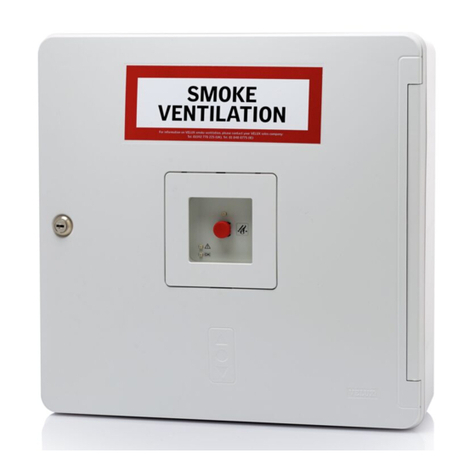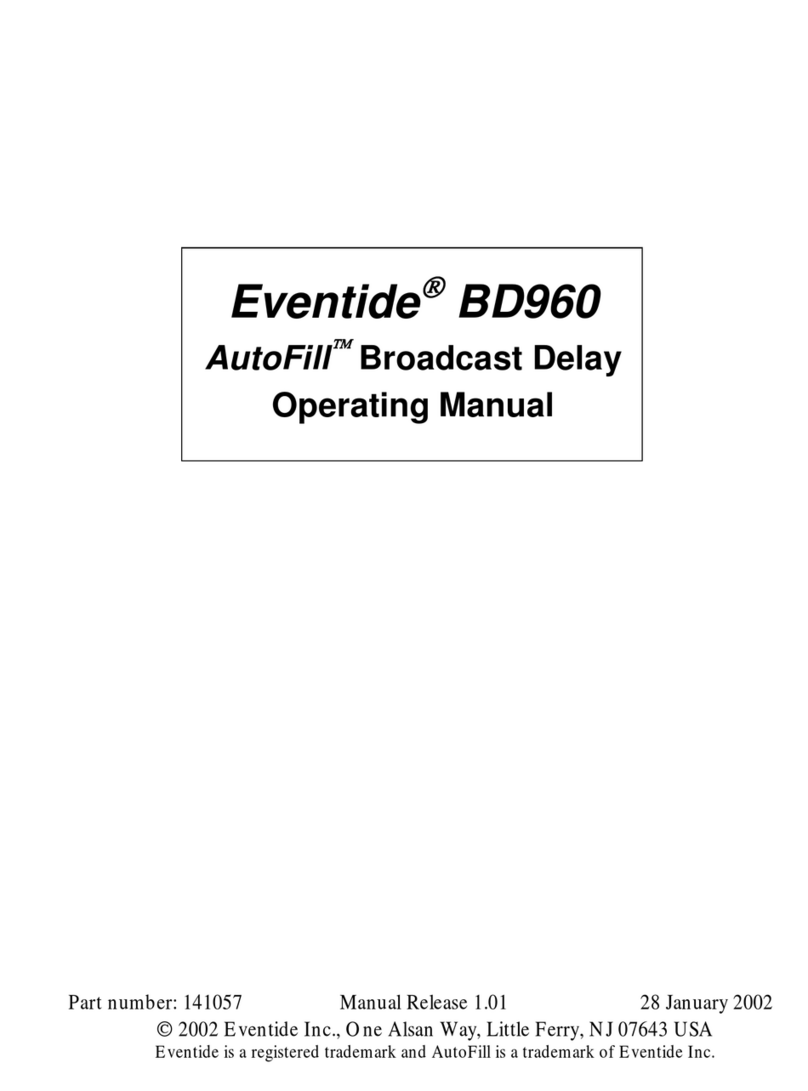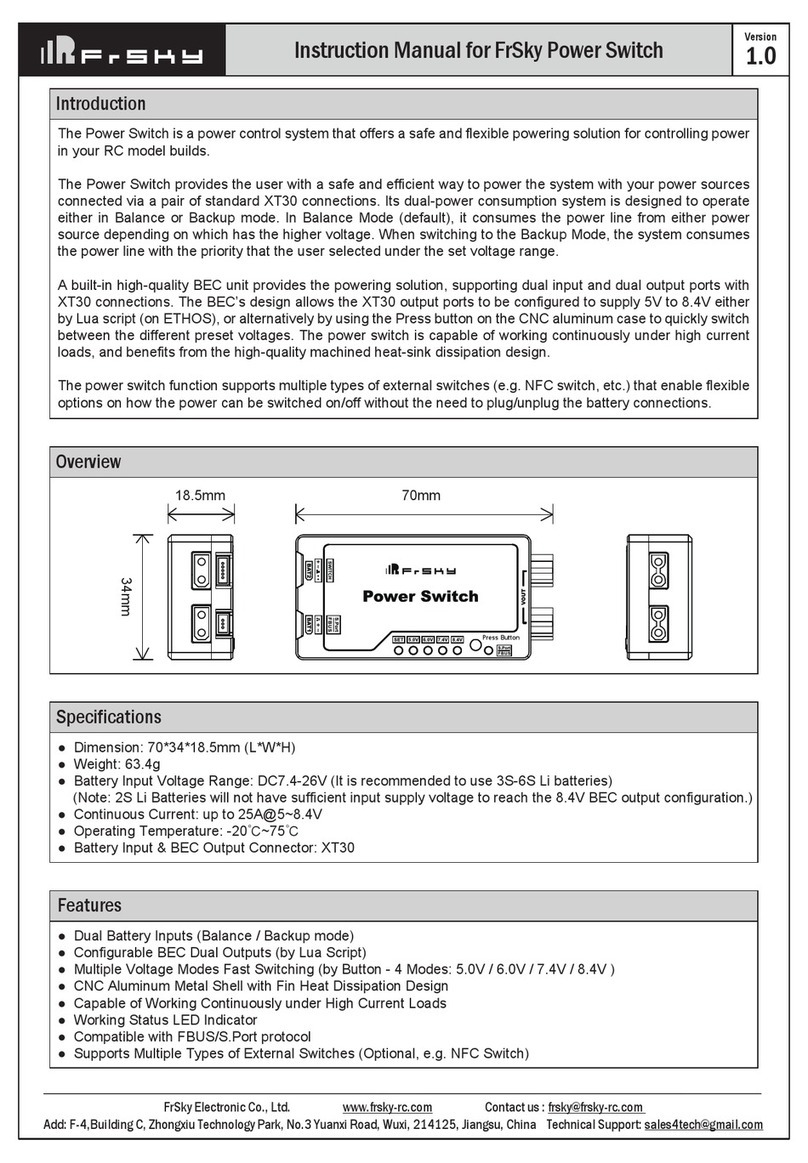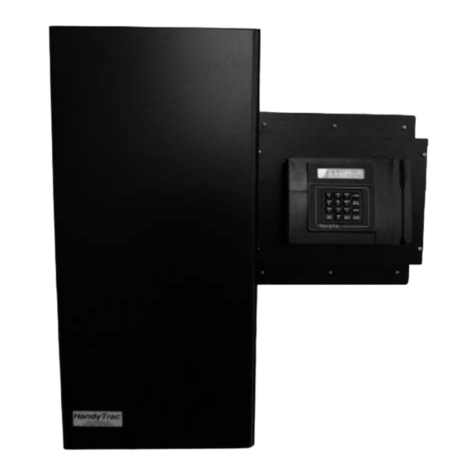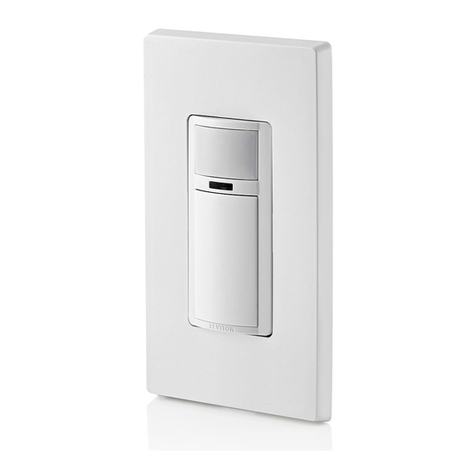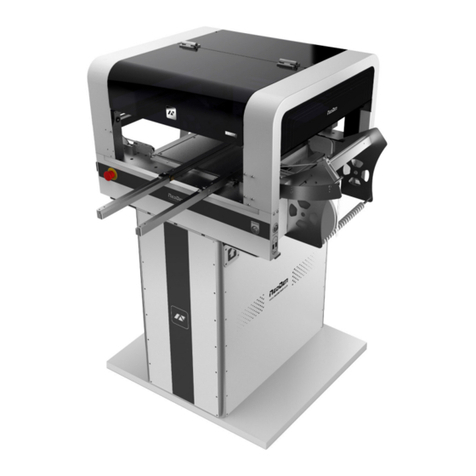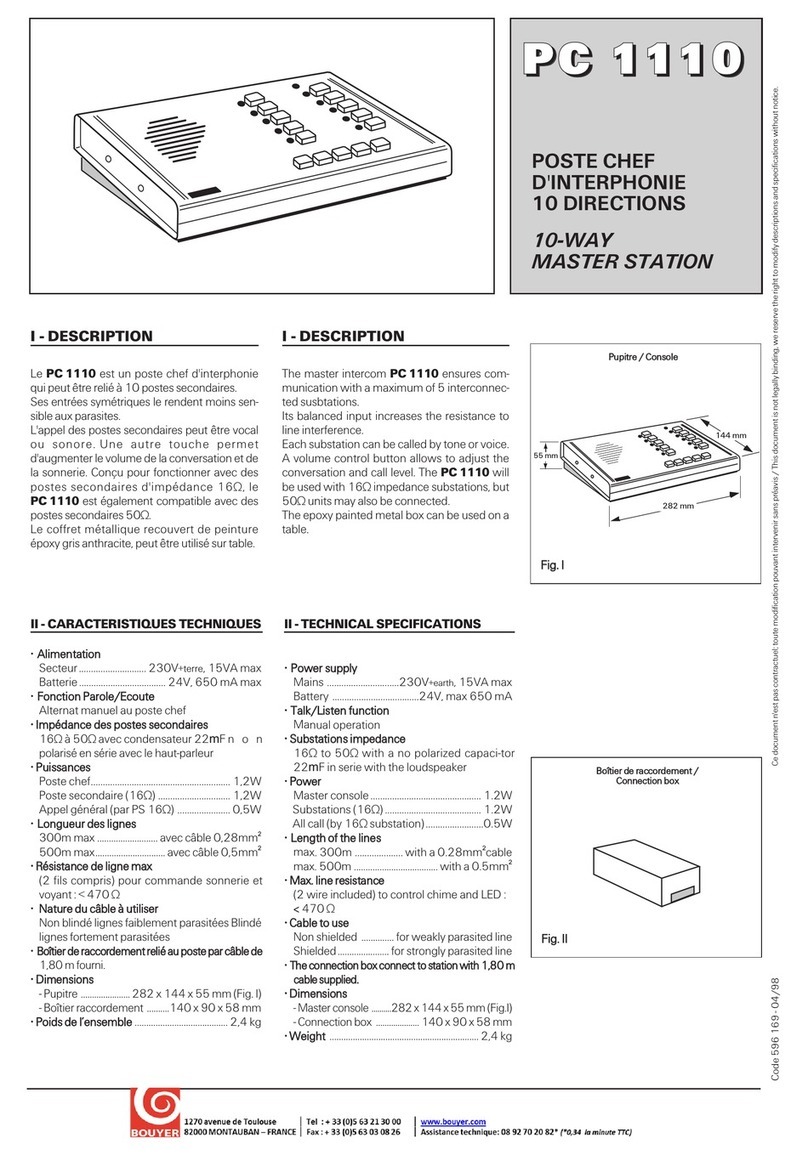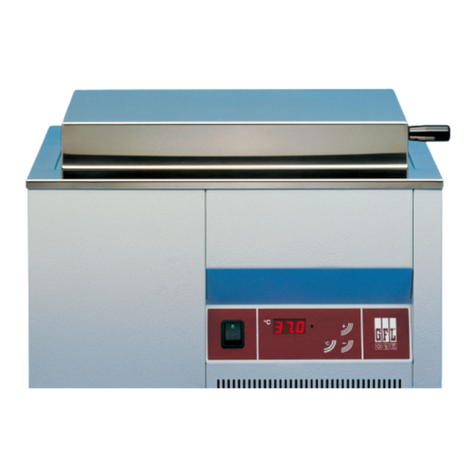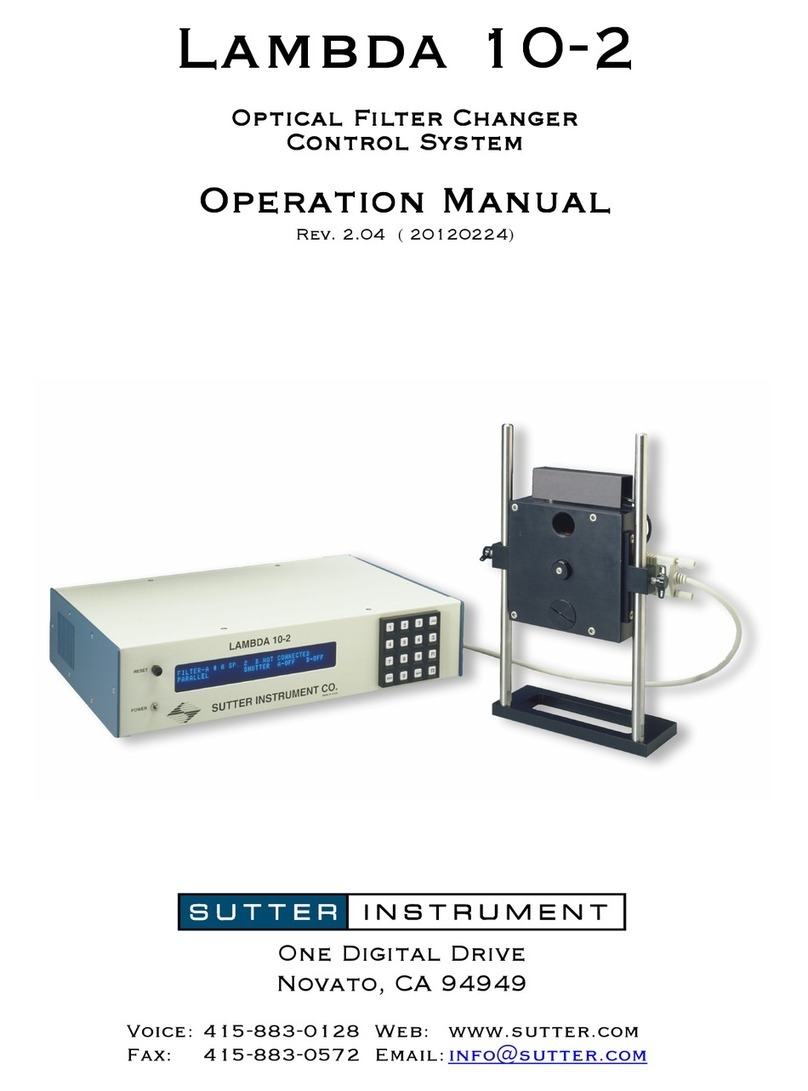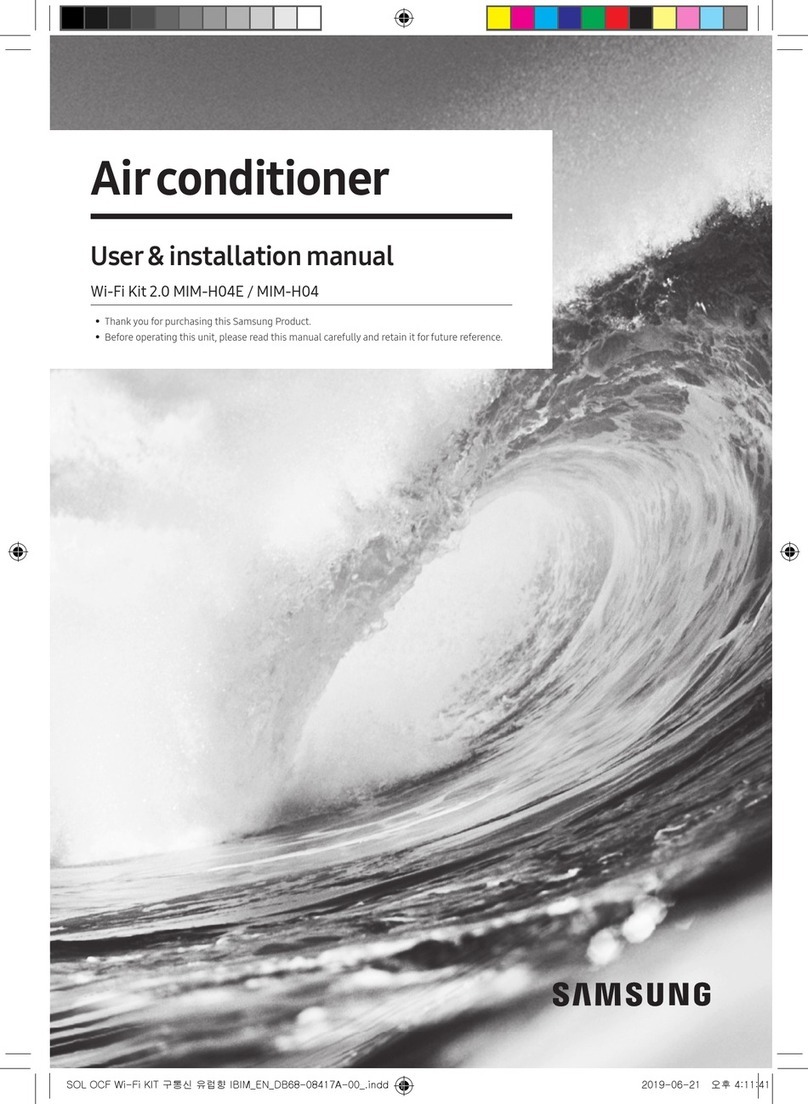Definox ACS Series Operation and maintenance manual

MAINTENANCE NOTICE
IT-TDFX-247 Revision 1 Page 1/45 October 2010
ACS CONTROL TOP
www.definox.com
AS-I version 2.1& 2.0
2I/1O & 4I/3O
Linear sensor version
(AS-i or multi-voltage)
1I + linear sensor / 3O
Terminal version
2I/1O & 4I/3O
Multi-voltage version
2I/1O & 4I/3O
Double-acting
(AS-I, multi-voltage, terminal) 2I/1O
ACS: Advanced
Control System

MAINTENANCE NOTICE
IT-TDFX-247 Revision 1 Page 2/45 October 2010
TABLE OF CONTENTS
1CHANGE MANAGEMENT 4
2SAFETY 5
2.1 Important information 5
2.2 General information 5
3INTRODUCTION 6
3.1 Disassembling the control top 6
3.1.1 Disassembling the unit/actuator 6
3.1.2 Disassembling the unit components 7
3.2 Reassembling the control top 8
3.2.1 Reassembling the unit components 8
3.2.2 Reassembling the unit / actuator 10
4TERMINAL VERSIONS 11
4.1 Wiring 2 sensors/1 solenoid valve 11
4.2 Wiring for 2 sensors / 3 solenoid valves 11
4.3 Electrical specifications 12
5MULTI-VOLTAGE MODULE VERSIONS 13
5.1 Module functions 13
5.2 Selecting the multi-voltage module version 13
5.3 24 V DC modules 14
5.3.1 Different input/output cabling 14
5.3.1.1 Description 14
5.4 24 V AC –48 V AC/DC modules 16
5.4.1 Different input/output wiring 16
5.4.1.1 Description 16
5.5 Wiring to the PLC 19
5.6 Wiring to the solenoid valves and sensors 20
5.7 Meaning of LEDs on the front of the modules 20
5.8 Technical specifications of the multi-voltage modules 21
5.9 1ST level maintenance 22
5.9.1 Power LED extinguished 22
5.9.2 Fault LED illuminated or flashing 22
5.9.3 Testing the solenoid valves 22
5.9.4 Testing the sensors 22
6AS-i MODULE VERSIONS 23
6.1 Wiring to AS-i network 23
6.2 Wiring to the solenoid valves and sensors 23
6.3 AS-i network 24
6.3.1 AS-i supplies 24
6.3.2 AS-i address programming 24
6.4 Meaning of LEDs on the front of the modules 25
6.5 Meaning of I/O bits via AS-i 25
6.6 Technical specifications of AS-i modules 26

MAINTENANCE NOTICE
IT-TDFX-247 Revision 1 Page 3/45 October 2010
7LINEAR SENSOR 27
7.1 Configuration and calibration 28
7.2 Calibration and configuration diagram 28
7.3 Possible faults during calibration 29
7.4 1st level maintenance 29
7.4.1 No signal from linear sensor 29
7.4.2 Cam outside detection range 29
7.4.3 Calibration error 29
7.5 Wiring 29
7.6 Technical specifications of the multi-voltage linear sensor modules 30
7.7 AS-i linear sensor module specifications 31
7.8 Linear sensor specifications 31
8CHANGE OF CONFIGURATION: changing from a NC to a NO valve configuration: 32
9ACS UNIT SPARE PARTS 33
9.1 ACS unit - Double-Acting - 2I/1O module - AS-I or multi voltage 33
9.2 ACS unit - Double-Acting - 2I/1O - Terminal 33
9.3 ACS unit - 1 SV - 2E/1S - AS-i or multi voltage 34
9.4 ACS unit - 2SV - module 4E/3S- AS-i or multi voltage 35
9.5 ACS unit - 3SV - module 4E/3S - AS-i or multi voltage 36
9.6 ACS unit - 3SV - 1I + Lin. Sens./3O - AS-I or multi voltage 37
9.7 ACS unit - 1SV - 2I/1O - terminal 38
9.8 ACS unit - 2SV - 2I/3O - terminal 39
9.9 ACS unit - 3SV - 2I/3O - terminal 39
9.10 List of ACS unit parts 40
9.11 Dimensions, assignment and reference of cams for ACS unit sensor(s) 42
9.11.1 For DPAX valves DN25 to 150 42
9.11.2 For DN8 full flow to 65 venturi DBAX valves 42
9.11.3 For DCX3 & 4 valves DN25 to 150 42
9.11.4 For VDCI PFA valves with breakaway cylinder DN38 to 150 43
9.11.5 For VDCI SP or VDCI PFA valves without breakaway cylinder DN38 to 150 43
9.11.6 For VDCI MC PFA DN38 to 125 valves 44
9.11.7 For VDCI MC SP/PMO valves DN38 to 125 44
9.11.8 For DMAX valves DN21.6 to 52 44
9.12 Dimensions, assignment and reference of cams for the linear sensor of ACS units 44
9.12.1 For VDCI MC PFA DN38 to 125 valves 44
9.12.2 For VDCI MC SP/PMO valves DN38 to 125 44

MAINTENANCE NOTICE
IT-TDFX-247 Revision 1 Page 4/45 October 2010
1 CHANGE MANAGEMENT
CHANGES
INDEX
DATE
PAGE(S)
INITIALS
Initial version
1
October 2010
/
F. MERLET

MAINTENANCE NOTICE
IT-TDFX-247 Revision 1 Page 5/45 October 2010
2 SAFETY
2.1 Important information
Always read the maintenance notice before manipulating the valve
Failure to observe these instructions can result in serious bodily injury or loss of life.
This can also result in less serious injuries or damage to the equipment.
Electricity can result in serious bodily injury or loss of life.
This can also result in less serious injuries or damage to the equipment.
2.2 General information
The following advice is given to ensure optimum use of the equipment.
The tasks must be performed in the order specified.
Forbidden or permitted actions:
NOTE !
DANGER !
NOTE !
DANGER !
CAUTION !
•
OK
<0.5 m
≥ 0.5 m
NO
Cleaning

MAINTENANCE NOTICE
IT-TDFX-247 Revision 1 Page 6/45 October 2010
DANGER !
MAINTENANCE NOTICE ACS control top
3 INTRODUCTION
The ACS control top fits onto NC, NO, double-acting and VDCI (double block and bleed) valves. It is available in 5
configurations:
2I/1O or 4I/3O module _ AS-i 2.1 or AS-i 2.0.
Multi-voltage module 2I/1O or 4I/3O _ 24 V DC or 24 V AC –48V AC/DC.
Module with 1I + linear sensor / 3O _ AS-i 2.1 or AS-i 2.0, multi-voltage 24 V DC or 24 V AC 48V AC/DC.
2I/1O or 4I/3O terminal.
Double-acting: 2I/1O terminal version; 2I/1O module version (AS-i or multi-voltage).
3.1 Disassembling the control top
3.1.1 Disassembling the unit/actuator
IMPORTANT: Before starting any work on the unit, it is important to ensure that the mains
supply is switched off, that the air supply is closed and that the circuit is purged.
Disassembling the cover
Turn the cover to align the pin with the pictogram,
then remove the cover by pulling upwards.
Disassembling connector - base / actuator
Disconnect the air pipes from the box.
Unscrew the stuffing box assembly, locate and
disconnect the wires on the terminal or on the supply
module, then remove the supply cable, or disconnect
andremove the cable from the AS-i module.
Unscrewthe locking screw.
Turnthe connector (with or without the cover)
to release the three locking studs of the base.
Separatebypulling upwards.
Unscrew the two CHC screws.
Remove the base from
the actuator.
Valve actuator
Cover
Connect
or
Base
Keying stud
locking screws

MAINTENANCE NOTICE
IT-TDFX-247 Revision 1 Page 7/45 October 2010
Nut
Connector
Terminal
M3
screw
Washer
M4
screw
3.1.2 Disassembling the unit components
Before disassembling the components, locate and disconnect the wires to the terminal or
disconnect the terminal from the module (AS-i or multi-voltage).
Disassembling the solenoid valves
For each solenoid valve, Unscrew the two fastening
screws on the solenoid valve and remove the
solenoid valve together with the seal.
Disassembling the modules OR
Unscrew the fastening screw of the module
(AS-i or multi-voltage) and remove.
Dismantling the sensors
Unscrew thefastening screw from the sensor support
sub-assembly and remove.
Unclip and remove the upper and lower sensors from
the support sub-assembly.
Disassembling the terminal
Disassembling the terminal: hold the nuts, unscrew
the M3 screws, remove the terminal.
Disassembling the terminalsupport,
Unscrew the M4 screw, remove the terminal support
from the connector.
Screw
Lower
sensor
Upper
sensor
Sensor support
sub-assembly
Connector
NOTE !
Connector
Module
Multi-voltage
2I/10 or 4I/3O
Screw
AS-i module
2I/10 or 4I/3O
Connector
S.V. 1
Screw
S.V. seal
S.V. 3
Screw
S.V. seal
Solenoid valve
assembly
S.V. 2

MAINTENANCE NOTICE
IT-TDFX-247 Revision 1 Page 8/45 October 2010
Toothed
segment freed
Removing the linear sensor (option)
Remove the clamp plate to free the toothed
segment byremoving the two fastening screws.
Turn the linear sensor anti-clockwise to completely
free the toothed segment.
Pull the linear sensor upwards to disconnect itfrom
the control top.
3.2 Reassembling the control top
3.2.1 Reassembling the unit components
Reassembling the linear sensor (option)
Vertically fit the linear sensor in place, ensuring
that the toothed segment is still free.
Turn the linear sensor clockwise as far as it
will go.
The toothed segment is no longer free.
Reposition the clamp plate and fit the 2 fastening
screws.The teeth of the plate must fit between
the teeth of the toothed segment to prevent
rotation.
oTightening torque: 0.8 Nm, i.e. 8 kgf.cm
Linear
sensor
Screw
Clamp
plate
Linear sensor
Toothed
segment not free
Linear sensor
Toothed
segment freed
Toothed
segment not free
Screw
Clamp plate
Linear sensor
Clamp plate teeth

MAINTENANCE NOTICE
IT-TDFX-247 Revision 1 Page 9/45 October 2010
Reassembling the terminal OR
As for removal, in reverse order:
position the terminal on the terminal support, fit the
two M3screws, the washers and the nuts.
oTightening torque: 0.1 Nm i.e. 1 kgf.cm
Place on the connector, fit the M4 screw.
oTightening torque: 0.8 Nm, i.e. 8 kgf.cm
Reassembling the module
As for removal, in reverse order:
Position the AS-i or multi-voltage module in its
housing within the connector. Fit the M3 screw on
the attachment point corresponding to the
configuration of the module.
oTightening torque: 0.3 Nm i.e. 3 kgf.cm
Reassembling the sensors
Clip the upper and lower sensors on the support
sub-assembly.
Re-position the sensor support sub-assembly on
the connector, fit the fastening screw.
oTightening torque: 0.8 Nm, i.e. 8 kgf.cm
Cam / sensor target adjustment: fine, precise
adjustment is made for each sensor with the
adjustment screw. The cam can be set anywhere
within a range extending from the centre of the
targetto the full target. To be adjusted as needed!
Reassembling the SV
Install SV1, then SV3 and lastlySV2.
Position the solenoid valve seal by aligning it with
the locating pin on the connector seating plane.
One side of the seal will bear against a guideface.
Align the solenoid with the same locating pins.
The body of the solenoid valve will touch against
the guide face or the bodyof SV3.
Fit the two M2.5 fastening screws.
oTightening torque: 0.4 Nm i.e. 4 kgf.cm
Full target
New, more accessible
attachment point on new unit.
Existing attachment point on
new version of unit and on
2004 version unit.
Centre of target
Sensor support
fastening screw
Sensor
Lower
Sensor
Upper
Sensor support
sub-assembly
Connecto
r
Sensor
adjustment
screw
Locating pin
Alignment hole
Guide face

MAINTENANCE NOTICE
IT-TDFX-247 Revision 1 Page 10/45 October 2010
3.2.2 Reassembling the unit / actuator
Reassembling connector -base / actuator
As for removal, in reverse order:
Position the base on the actuator.
Place the two M8 CHC screws.
oTightening torque: 1 Nm i.e. 10 kgf.cm
Position the connector (with or without its cover)
on the keying studs on the base.
Turn the connector to lock it on the base.
Tighten the locking screw to secure.
Connect the pneumatic system.
Remove the cover if necessary, and connect the
wiring according to the type of unit and in
accordance with the diagrams given herein.
Tighten the cable gland.
In order to ensure that it is
mounted on the keying
studs, position the shape
with the letter "A" on the
connector relative to the
base as shown in the
figure below:
Reassembling the cover
As for removal, in reverse order:
Align the pin of the cover with the "open cover"
pictogram, and bring the cover into contact with the
connector.
Turn the cover in the direction of its locking arrow
until the pin is above the "cover locked" pictogram.
Note:
Under normal operation, the base, the connector and
the cover can, if necessary, be lead-sealed by means
of a wire or a screw in a hole passing through the
entire control top.
Keying stud
locking screws
Valve actuator
Cover
Connect
or
Base
NOTE !

MAINTENANCE NOTICE
IT-TDFX-247 Revision 1 Page 11/45 October 2010
4 TERMINAL VERSIONS
The terminal versions allow you to connect the sensors and the solenoid valves directly to the PLC.
In this case the operating voltage of the sensors and the solenoid valves is only 24 V DC +/- 10%.
4.1 Wiring 2 sensors/1 solenoid valve
Part name
Function
V+
+ sensor supply (+24 V DC)
V-
Sensor earth
I1
Retro data valve closed (PNP)
I2
Retro data valve open (PNP)
EV1
Solenoid valve 1 control (+24 V DC)
(main actuator)
EV-
Solenoid valve earth
Part name
Function
V+
+ sensor supply (+24 V DC)
V-
Not connected
I1
Retro data valve closed (PNP)
I2
Retro data valve open (PNP)
EV1
Solenoid valve 1 control (+24 V DC)
(main actuator)
EV-
Solenoid valve earth
4.2 Wiring for 2 sensors / 3 solenoid valves
Part name
Function
V+
+ sensor supply (+24 V DC)
V-
Sensor earth
I1
Retro data valve closed (PNP)
I2
Retro data valve open (PNP)
EV1
Solenoid valve control 1 (+24 V DC)
(main actuator)
EV2
Solenoid valve 2 control (+24 V DC)
(upper plug)
EV3
Solenoid valve 3 control (+24 V DC)
(lower plug)
EV-
Solenoid valve earth
Wiring for 2 wire sensors and solenoid valve on 2I / 1O terminal (Version on request)
White
Black
Black
Lower
sensor
Upper
sensor
SV1 (Main
actuator)
Red
White
Black
Brown
Blue
Brown
Blue
Red
Black
Lower
sensor
Upper
sensor
SV1 (Main
actuator)
Black
Black
Wiring for 3 wire sensors and solenoid valve on 2I / 1O terminal (Standard version)
Wiring for 3 wire sensors and solenoid valves on 2I / 3O terminal (Standard version)
Red
Black
Red
Lower
sensor
Upper
sensor
Black
Red
Black
Red
Black
Red
Black
SV1 (Main
actuator)
SV2 (Upper plug)
SV3 (Lower plug)
Blue
Blue

MAINTENANCE NOTICE
IT-TDFX-247 Revision 1 Page 12/45 October 2010
4.3 Electrical specifications
General specifications
Supply voltage
Sensors
Solenoid valves
Current consumed for 1 active solenoid valve and 1 active sensor
Temperature
Operating
storage/transport
24 V DC +/- 10%
24 V DC +/- 10%
40 mA DC
-10 to +60 °C
-40 to +85 °C
Sensors
Supply voltage
Output current
Inductive sensor connection
2 wires: on request
3 wires: standard
24 V DC +/- 10%
50 mA max
Yes
Solenoid valves
Supply voltage
Current consumed
Switching frequency on inductive load
24 V DC +/- 10%
30 mA max
0.5 Hz
Electrical connections to PLC
Connection type
Conductor section
Spring cage terminal
0.75 mm² max.
A cross section of 0.5 mm² is sufficient.
Cable diameter: 4.5 to 10 mm.
Part name
Function
V+
+ sensor supply (+24 V DC)
V-
Not connected
I1
Retro data valve closed (PNP)
I2
Retro data valve open (PNP)
EV1
Solenoid valve 1 control (+24 V DC) (main actuator)
EV2
Solenoid valve 2 command (+24 V DC) (upper plug)
EV3
Solenoid valve 3 command (+24 V DC) (lower plug)
EV-
Solenoid valve earth
Wiring for 2 wire sensors and solenoid valves on 2I/3O terminal (Version on request)
Brown
Sensor
Lower
Sensor
Upper
Blue
Black
Brown
Blue
Black
White
Black
White
Lower
sensor
Upper
sensor
Black
Red
Black
Red
Black
Red
Black
SV1 (Main
actuator)
SV2 (Upper plug)
SV3 (Lower plug)

MAINTENANCE NOTICE
IT-TDFX-247 Revision 1 Page 13/45 October 2010
5 MULTI-VOLTAGE MODULE VERSIONS
The 24 V DC and 24 V AC-48 V AC/DC multi-voltage modules provide an interface between the peripheral
devices (solenoid valves, sensors) and the command control system (PLC). Two different voltages can be used
at the same time on the module.
Terminology:
The input signals correspond to the solenoid valve commands.
The output signals correspond to the retro data signals from the sensors.
5.1 Module functions
Electronic module:
Adapts the electrical signals between the PLC and the sensors/solenoid valves that only operate
at 24 V DC.
Allows you to select the type of signals PNP, NPN or NO (using jumpers).
Displays the states of the I/O, supply and faults.
In order for the module to be permanently supplied, it must be ensued that the
connecting cable has sufficient conductors! (6 conductors min for a 1 solenoid valve,
2 sensor unit: 2 for the module power supply, 2 for the sensor retro data, 2 for the
solenoid valve. To be adapted to suit the number of solenoid valves)
5.2 Selecting the multi-voltage module version
According to the voltages used on the installation, different module versions are available:
I/O
PLC
MULTI-
VOLTAGE
MODULE
Output
s
Inputs
Sensors
Solenoid
valves
YES
YES
NO
NO
24 V DC supply
available?
Multi-voltage module
24 V AC –48 V AC/DC
Signal voltages
Solenoid valves 24 V AC,
48 V AC or 48 V DC and
Retro data sensors 24 V
AC, 48 V AC or 48 V DC
N.B.: The supply voltage
must be common to the
solenoid valve voltages or
sensors.
Multi-voltage module
24 V DC
Retro data sensors
24 V DC?
Signal voltages
Solenoid valves 24 V DC
and
Retro data sensors 24 V DC,
24 V AC, 48 V AC or 48 V DC
Signal voltages
Solenoid valves 24 V DC, 24 V AC,
48 V AC or 48 V DC
and
Retro data sensors 24 V DC
Multi-voltage module:
Ref. 7708050 (2I/1O)
Ref. 7708051 (4I/3O)
Ref. 7708103 (1I+linear sensor/3O)
Multi-voltage module:
Ref. 7708052 (2I/1O)
Ref. 7708053 (4I/3O)
Ref. 7708104 (1I+linear sensor/3O)
IMPORTANT

MAINTENANCE NOTICE
IT-TDFX-247 Revision 1 Page 14/45 October 2010
5.3 24 V DC modules
The electrical supply of the multi-voltage module must be 24 V DC and permanent.
The solenoid valve signals or ,thesensor signals can have a different voltage (24 V AC, 48 V DC or 48 V AC) to 24 V DC,
but never at the same time.
5.3.1 Different input/output cabling
5.3.1.1 Description
The table below gives the following 8 possible wiring diagrams:
Different voltages,
Signal types (PNP, NPN, NO, common used).
Example:
- Solenoid valve signals: 48 V AC + common independent,
- Sensor signals + fault: 24 V DC output PNP.
The diagram to be used is number 5.
Comments:
Initially, the module is configured to be wired according to diagram number 3.
The bold marks on the wiring diagrams represent the jaws of the CO and CI connectors
(use tool 7708097 to remove or move the jaws).
Table of the 8 possible wiring diagrams
SOLENOID VALVE SIGNALS
Connector (CO)
24 V DC
Independent
SENSOR SIGNALS + FAULT
Output
Voltage
V+
V-
PNP
24 V DC
Diagram No. 1
Diagram No. 3
Diagram No. 5
48 V DC
Diagram No. 8
Diagram No. 7
NPN
24 V DC
Diagram No. 2
Diagram No. 4
Diagram No. 6
48 V DC
Diagram No. 8
Diagram No. 7
NO
24 V AC,
48 V AC
Diagram No. 8
Diagram No. 7
CAUTION!
2-point wiring jaws that links the CI and CO
connectors to V+ or V-.
NOTE !

MAINTENANCE NOTICE
IT-TDFX-247 Revision 1 Page 15/45 October 2010
24VDC x x
24VAC
48VDC
48VAC
24VDC x x
24VAC
48VDC
48VAC
24VDC x x
24VAC
48VDC
48VAC
24VDC x x
24VAC
48VDC
48VAC
24VDC x
24VAC x
48VDC x
48VAC x
24VDC x
24VAC x
48VDC x
48VAC x
24VDC x
24VAC x
48VDC x
48VAC x
24VDC x
24VAC x
48VDC x
48VAC x
O3
O2
O3
I4
I3
I2
I1
CI
V+
V-
O3
O2
O3
I4
I3
I2
I1
CI
V+
V-
PNP OUTPUT SENSORS
DIAGRAM
NO. 1
Signals:
- Solenoid valves: Connector (CO) to 24 V DC
- Sensors: 24 V DC output PNP
24 V DC (V+)
GND (V-)
Open (I1)
Closed (I2)
Cde_Main_Actuator (O1)
Common_Command (CO)
Common_Info (CI)
Power
supply
Valve
position
Valve
control
SV
Sensor
Upper_Plug_Cde (O2)
DIAGRAM
NO.3
Signals:
- Solenoid valves: Connector (CO) to GND
- Sensors: 24 V DC output PNP
24 V DC (V+)
GND (V-)
Open (I1)
Closed (I2)
Cde_Main_Actuator (O1)
Common_Command (CO)
Common_Info (CI)
Power
supply
Valve
position
Valve
control
SV
Sensor
Upper_Plug_Cde (O2)
DIAGRAM
NO. 2
Signals:
- Solenoid valves: Connector (CO) to 24 V DC
- Sensors: 24 V DC outputs NPN
24 V DC (V+)
GND (V-)
Open (I1)
Closed (I2)
Cde_Main_Actuator (O1)
Common_Command (CO)
Common_Info (CI)
Power
supply
Valve
position
Valve
control
SV
Sensor
Upper_Plug_Cde (O2)
DIAGRAM
NO. 4
Signals:
- Solenoid valves: Connector (CO) to GND
- Sensors: 24 V DC outputs NPN
24 V DC (V+)
GND (V-)
Open (I1)
Closed (I2)
Cde_Main_Actuator (O1)
Common_Command (CO)
Common_Info (CI)
Power
supply
Valve
position
Valve
control
SV
Sensor
Upper_Plug_Cde (O2)
NPN OUTPUT SENSORS
PNP OUTPUT SENSORS
NPN OUTPUT SENSORS
DIAGRAM
NO. 6
Signals:
- Solenoid valves: Connector (CO) independent
- Sensors: 24 V DC outputs NPN
24 V DC (V+)
GND (V-)
Open (I1)
Closed (I2)
Cde_Main_Actuator (O1)
Common_Command (CO)
Common_Info (CI)
Power
supply
Valve
position
Valve
control
SV
Sensor
Upper_Plug_Cde (O2)
DIAGRAM
NO. 5
Signals:
- Solenoid valves: Connector (CO) independent
- Sensors: 24 V DC output PNP
24 V DC (V+)
GND (V-)
Open (I1)
Closed (I2)
Cde_Main_Actuator (O1)
Common_Command (CO)
Common_Info (CI)
Power
supply
Valve
position
Valve
control
SV
Sensor
Upper_Plug_Cde (O2)
DIAGRAM
NO. 7
Signals:
- Solenoid valves: Connector (CO) to GND
- Sensors: PNP, NPN or NO outputs connector
independent.
24 V DC (V+)
GND (V-)
Open (I1)
Closed (I2)
Cde_Main_Actuator (O1)
Common_Command (CO)
Common_Info (CI)
Power
supply
Valve
position
Valve
control
SV
Sensor
Upper_Plug_Cde (O2)
DIAGRAM
NO. 8
Signals:
- Solenoid valves: Connector (CO) to 24 V DC
- Sensors: PNP, NPN or NO outputs connector
independent.
24 V DC (V+)
GND (V-)
Open (I1)
Closed (I2)
Cde_Main_Actuator (O1)
Common_Command (CO)
Common_Info (CI)
Power
supply
Valve
position
Valve
control
SV
Sensor
Upper_Plug_Cde (O2)
PNP, NPN OR NO OUTPUT SENSORS
O3
O2
O3
I4
I3
I2
I1
V+
V-
O3
O2
O3
I4
I3
I2
I1
V+
V-
O3
O2
O3
I4
I3
I2
I1
V+
V-
O3
O2
O3
I4
I3
I2
I1
V+
V-
O3
O2
O3
CO
I4
I3
I2
I1
V+
V-
O3
O2
O3
CO
I4
I3
I2
I1
V+
V-

MAINTENANCE NOTICE
IT-TDFX-247 Revision 1 Page 16/45 October 2010
5.4 24 V AC –48 V AC/DC modules
The electricalsupplyof the multi-voltage modulemust be 24 V AC, 48 V AC or 48 VDC, and permanent
The solenoid valve signals or the sensor signals can have a different voltage (24 V AC, 48 V AC or 48 V DC) to the supply,
but never at the same time.
5.4.1 Different input/output wiring
5.4.1.1 Description
The table below gives the following 14 possible wiring diagrams:
Different voltages,
Signal types (PNP, NPN, NO, common used).
Example:
- Power supply 48 V AC,
- Solenoid valve signals: 48 V AC,
- Sensor signals + fault: 24 V AC outputs NO.
The diagram to be used is number 6.
Comments:
Initially, the module is configured to be wired according to diagram number 1 or 2.
The bold marks on the wiring diagrams represent the jaws of the CO and CI connectors
(use tool 7708097 to remove or move the jaws).
Table of the 14 possible wiring diagrams
SOLENOID VALVE SIGNALS
Connector (CO)
SENSOR SIGNALS + FAULT
Output
Voltage
24 V AC
48 V AC
48 V DC
Independent
V+
V-
NO
24 V AC
Diagram No. 1
Diagram No. 6
Diagram
No. 13
Diagram
No. 14
Diagram No. 3
NO
48 V AC
Diagram No. 5
Diagram No. 2
Diagram
No. 13
Diagram
No. 14
Diagram No. 4
PNP
48 V DC
Diagram No. 5
Diagram No. 6
Diagram
No. 7
Diagram
No. 8
Diagram No. 11
NPN
Diagram No. 5
Diagram No. 6
Diagram
No. 9
Diagram
No. 10
Diagram No. 12
2-point wiring jaws that links the CI and CO
connectors to V+ or V-.
CAUTION!
NOTE !

MAINTENANCE NOTICE
IT-TDFX-247 Revision 1 Page 17/45 October 2010
24VAC x x
48VDC
48VAC
24VAC
48VDC x x
48VAC
x
24VAC x
48VDC x
48VAC
x
24VAC x
48VDC x
48VAC
24VAC x
48VDC x
48VAC x
24VAC x
48VDC x
48VAC x
O3
O2
O3
I4
I3
I2
I1
CI
24
V
AC
NO OUTPUT SENSORS
DIAGRAM
NO. 1
Signals:
- Solenoid valves: Connector (CO) to V+
- Sensors: 24 V AC NO outputs
(V+)
(V-)
Open (I1)
Closed (I2)
Cde_Main_Actuator (O1)
Common_Command (CO)
Common_Info (CI)
Power
supply
Valve
position
Valve
control
SV
Sensor
Upper_Plug_Cde (O2)
24 V
AC
48 V
AC
DIAGRAM
NO. 2
Signals:
- Solenoid valves: Connector (CO) to V+
- Sensors: 48 V AC NO outputs
(V+)
(V-)
Open (I1)
Closed (I2)
Cde_Main_Actuator (O1)
Common_Command (CO)
Common_Info (CI)
Power
supply
Valve
position
Valve
control
SV
Sensor
Upper_Plug_Cde (O2)
Upper_Plug_Cde (O2)
DIAGRAM
NO.3
Signals:
- Solenoid valves: Connector (CO) independent
- Sensors: 24 V AC NO outputs
(V+)
(V-)
Open (I1)
Closed (I2)
Cde_Main_Actuator (O1)
Common_Command (CO)
Common_Info (CI)
Power
supply
Valve
position
Valve
control
SV
Sensor
24 V
AC
DIAGRAM
NO. 4
Signals:
- Solenoid valves: Connector (CO) independent
- Sensors: 48 V AC NO outputs
(V+)
(V-)
Open (I1)
Closed (I2)
Cde_Main_Actuator (O1)
Common_Command (CO)
Common_Info (CI)
Power
supply
Valve
position
Valve
control
SV
Sensor
Upper_Plug_Cde (O2)
48 V
AC
DIAGRAM
NO. 5
Signals:
- Solenoid valves: Connector (CO) to V+
- Sensors: 48 V DC PNP or NPN outputs 48 V
AC NO outputs
(V+)
(V-)
Open (I1)
Closed (I2)
Cde_Main_Actuator (O1)
Common_Command (CO)
Common_Info (CI)
Power
supply
Valve
position
Valve
control
SV
Sensor
Upper_Plug_Cde (O2)
24 V
AC
DIAGRAM
NO. 6
Signals:
- Solenoid valves: Connector (CO) to V+
- Sensors: 48 V DC PNP or NPN outputs 24 V
AC NO outputs
(V+)
(V-)
Open (I1)
Closed (I2)
Cde_Main_Actuator (O1)
Common_Command (CO)
Common_Info (CI)
Power
supply
Valve
position
Valve
control
SV
Sensor
Upper_Plug_Cde (O2)
48 V
AC
PNP, NPN OR NO OUTPUT SENSORS (connector independent)
O3
O2
O3
I4
I3
I2
I1
48
V
AC
O3
O2
O3
I4
I3
I2
I1
24
V
AC
O3
O2
O3
I4
I3
I2
I1
CO
48
V
AC
O3
O2
O3
I4
I3
I2
I1
CI
48
V
AC
O3
O2
O3
I4
I3
I2
I1
24
V
AC
CO

MAINTENANCE NOTICE
IT-TDFX-247 Revision 1 Page 18/45 October 2010
24VAC
48VDC x x
48VAC
24VAC x x
48VDC
48VAC
24VAC x x
48VDC
48VAC
24VAC x x
48VDC
48VAC
24VAC x
48VDC x
48VAC x
x
24VAC x
48VDC x
48VAC
x
24VAC x
48VDC x
48VAC
24VAC x
48VDC x
48VAC x
DIAGRAM
NO. 7
Signals:
- Solenoid valves: Connector (CO) to 48 V DC
- Sensors: 48 V DC outputs PNP
48 V DC (V+)
(V-)
Open (I1)
Closed (I2)
Cde_Main_Actuator (O1)
Common_Command (CO)
Common_Info (CI)
Power
supply
Valve
position
Valve
control
SV
Sensor
Upper_Plug_Cde (O2)
PNP OUTPUT SENSORS
NPN OUTPUT SENSORS
DIAGRAM
NO. 8
Signals:
- Solenoid valves: Connector (CO) to 48 V DC
- Sensors: 48 V DC outputs NPN
48 V DC (V+)
(V-)
Open (I1)
Closed (I2)
Cde_Main_Actuator (O1)
Common_Command (CO)
Common_Info (CI)
Power
supply
Valve
position
Valve
control
SV
Sensor
Upper_Plug_Cde (O2)
DIAGRAM
NO. 9
Signals:
- Solenoid valves: Connector (CO) to GND
- Sensors: 48 V DC outputs PNP
48 V DC (V+)
(V-)
Open (I1)
Closed (I2)
Cde_Main_Actuator (O1)
Common_Command (CO)
Common_Info (CI)
Power
supply
Valve
position
Valve
control
SV
Sensor
Upper_Plug_Cde (O2)
DIAGRAM NO. 10
Signals:
- Solenoid valves: Connector (CO) to GND
- Sensors: 48 V DC outputs NPN
48 V DC (V+)
(V-)
Open (I1)
Closed (I2)
Cde_Main_Actuator (O1)
Common_Command (CO)
Common_Info (CI)
Power
supply
Valve
position
Valve
control
SV
Sensor
Upper_Plug_Cde (O2)
DIAGRAM NO.
11
Signals:
- Solenoid valves: Connector (CO) independent
- Sensors: 48 V DC outputs PNP
48 V DC (V+)
(V-)
Open (I1)
Closed (I2)
Cde_Main_Actuator (O1)
Common_Command (CO)
Common_Info (CI)
Power
supply
Valve
position
Valve
control
SV
Sensor
Upper_Plug_Cde (O2)
DIAGRAM NO. 12
Signals:
- Solenoid valves: Connector (CO) independent
- Sensors: 48 V DC outputs NPN
48 V DC (V+)
(V-)
Open (I1)
Closed (I2)
Cde_Main_Actuator (O1)
Common_Command (CO)
Common_Info (CI)
Power
supply
Valve
position
Valve
control
SV Sensor
Upper_Plug_Cde (O2)
DIAGRAM NO.
13
Signals:
- Solenoid valves: Connector (CO) to 48 V DC
- Sensors: NO outputs connector independent
Power
supply
Valve
position
Valve
control
SV
Sensor
48 V DC (V+)
(V-)
Open (I1)
Closed (I2)
Cde_Main_Actuator (O1)
Common_Command (CO)
Common_Info (CI)
Upper_Plug_Cde (O2)
DIAGRAM NO. 14
Signals:
- Solenoid valves: Connector (CO) to GND
- Sensors: NO outputs connector independent
Power
supply
Valve
position
Valve
control
SV
Sensor
48 V DC (V+)
(V-)
Open (I1)
Closed (I2)
Cde_Main_Actuator (O1)
Common_Command (CO)
Common_Info (CI)
Upper_Plug_Cde (O2)
NO OUTPUT SENSORS
O3
O2
O3
I4
I3
I2
I1
V+
V-
O3
O2
O3
I4
I3
I2
I1
V+
V-
O3
O2
O3
I4
I3
I2
I1
V+
V-
O3
O2
O3
I4
I3
I2
I1
V+
V-
O3
O2
O3
CO
I4
I3
I2
I1
V+
V-
O3
O2
O3
CO
I4
I3
I2
I1
V+
V-
O3
O2
O3
I4
I3
I2
I1
CI
V+
V-
O3
O2
O3
I4
I3
I2
I1
CI
V+
V-

MAINTENANCE NOTICE
IT-TDFX-247 Revision 1 Page 19/45 October 2010
5.5 Wiring to the PLC
Part name
Function
V+
+ Power supply
V-
- Power supply
O1
Solenoid valve control 1 (main actuator)
CO
Solenoid valve connector command
See the wiring table
I1
Retro data valve closed
I2
Retro data valve open
FLT
Retro data error
CI
Common retro data
See the wiring table
Part name
Function
V+
+ Power supply
V-
- Power supply
O1
Solenoid valve control 1 (main actuator)
O2
Solenoid valve 2 command (upper plug)
O3
Solenoid valve 3 command (lower plug)
CO
Solenoid valve connector command
See the wiring table
I1
Retro data valve closed
I2
Retro data valve open
I3
Retro data Upper plug opening
I4
Not Connected
FLT
Retro data error
CI
Common retro data
See the wiring table
Part name
Function
V+
+ Power supply
V-
- Power supply
O1
Solenoid valve control 1 (main actuator)
O2
Solenoid valve 2 command (upper plug)
O3
Solenoid valve 3 command (lower plug)
CO
Solenoid valve connector command
See the wiring table
I1
Retro data valve closed
I2
Retro data valve open
I3
Retro data Upper plug opening
I4
Lower plug opening retro data
FLT
Retro data error
CI
Common retro data
See the wiring table
2I/1O modules
4I / 3O modules
Tool location for opening spring cage and
inserting wire(s)
Module power
supply
I2
I1
V-
CI
V+
V+
V-
O1
FLT
V-
CO
V+
1I+linear sensor / 3O modules
Tool location for opening spring cage and
inserting wire(s)
Module power
supply
I4
I3
I2
I1
V-
CI
V+
V+
V-
O3
O2
O1
FLT
V-
CO
V+
Tool location for opening spring cage and
inserting wire(s)
Module power
supply
I4
I3
I2
I1
V-
CI
V+
V+
V-
O3
O2
O1
FLT
V-
CO
V+

MAINTENANCE NOTICE
IT-TDFX-247 Revision 1 Page 20/45 October 2010
5.6 Wiring to the solenoid valves and sensors
5.7 Meaning of LEDs on the front of the modules
The front of each module is fitted with LEDs that display the states of the inputs/outputs, as well as the
presence of the power supply or a local fault.
: Status of the sensor valve open
Yellow LED illuminated –Valve open
: Status of the sensor valve closed
Yellow LED illuminated –Valve closed
:Upper plug sensor status.
Yellow LED illuminated = Upper plug open.
:Lower plug sensor status
Yellow LED illuminated = Lower plug open.
: Status of the main actuator solenoid valve
Yellow LED illuminated –Solenoid valve controlled
: Upper plug solenoid valve output status
Yellow LED illuminated –Solenoid valve controlled
: Lower plug solenoid valve output status
Yellow LED illuminated –Solenoid valve controlled
PWR:Power supply on
Green LED illuminated = Power supply on
FAULT: Indicates the status of the module.
Red LED illuminated = Supply voltage too low or overload
or short-circuit on a peripheral of the unit (faulty solenoid
valve, ….).
Red LED flashing = Overload or short-circuit on
a peripheral.
Wiring for sensors and solenoid valve on 2I/1O modules
MAIN
ACTUATOR
Wiring for sensors and solenoid valve on 2I/3O modules
UPPER PLUG
LOWER PLUG
White
Black
White
Lower
sensor
Upper
sensor
Black
Red
Black
Red
Black
Red
Black
SV1 (Main
actuator)
SV2 (Upper plug)
SV3 (Lower plug)
V+
V+
V-
V-
I1
I2
O1
V-
I3
I4
O2
O3
V-
V+
V+
V-
V-
I1
I2
O1
V-
White
Black
White
Black
Red
Black
Lower
sensor
Upper
sensor
SV1 (Main
actuator)
Table of contents
Popular Control System manuals by other brands
Interroll
Interroll MultiControl AI operating manual

Modine Manufacturing
Modine Manufacturing Atherion MPR System manual
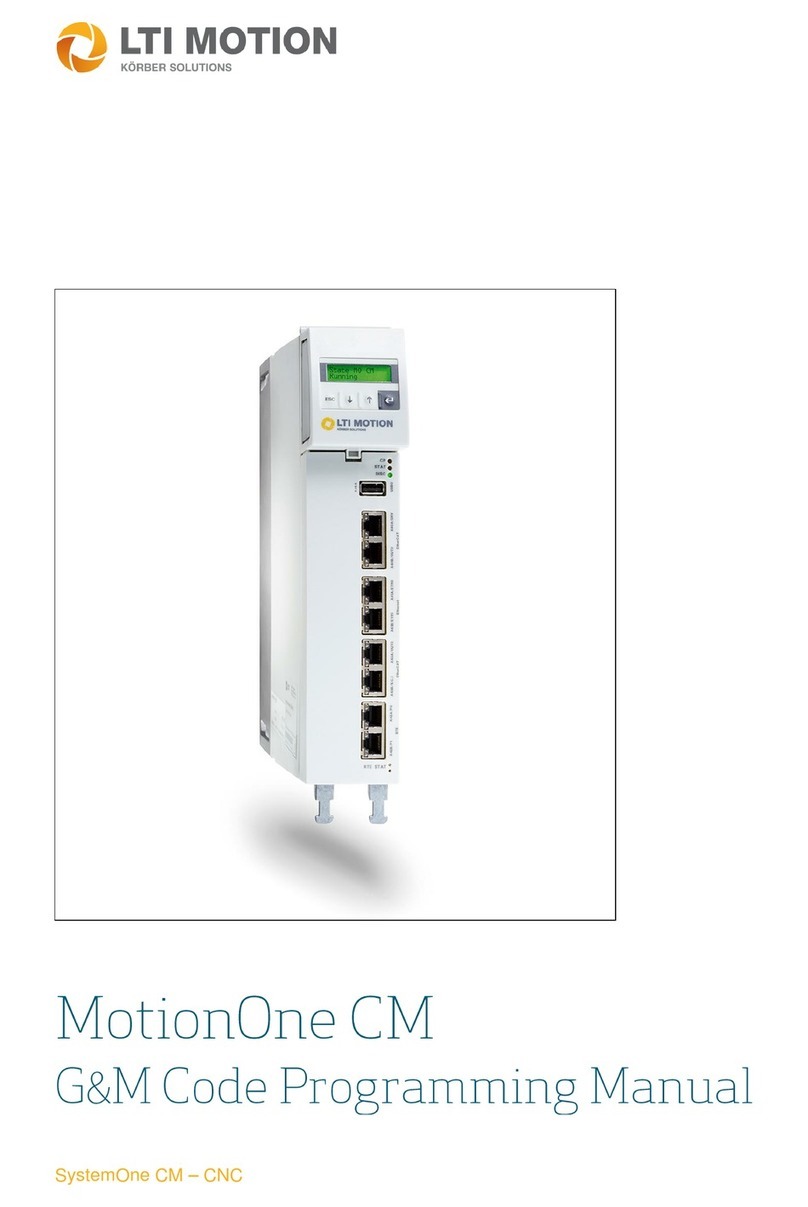
LTI MOTION
LTI MOTION MotionOne CM Programming manual
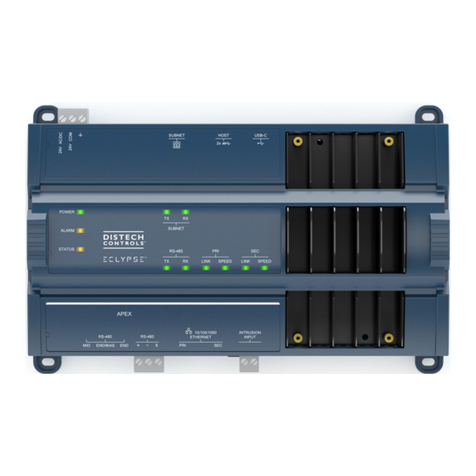
Distech Controls
Distech Controls ECLYPSE APEX user guide

New lift
New lift ECO manual
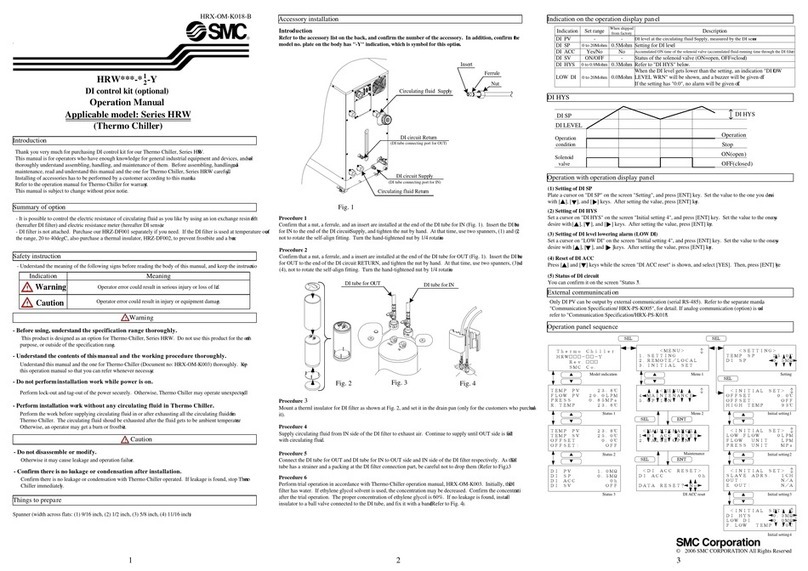
SMC Networks
SMC Networks HRW Series Operator's manual
